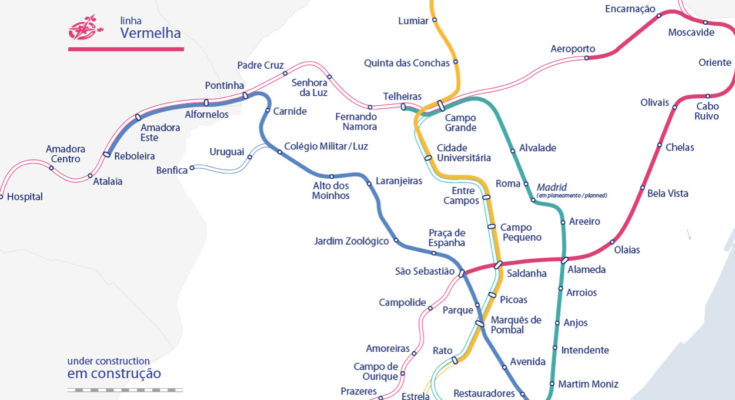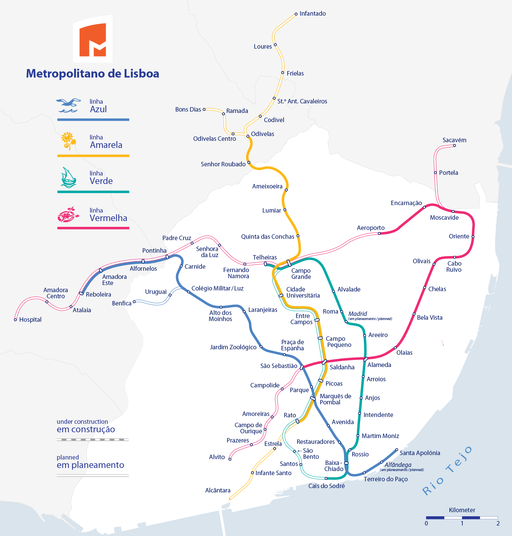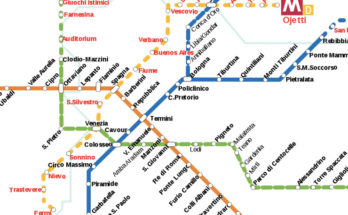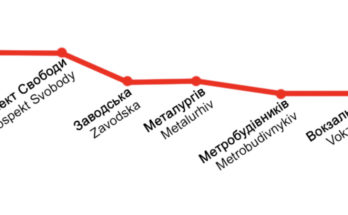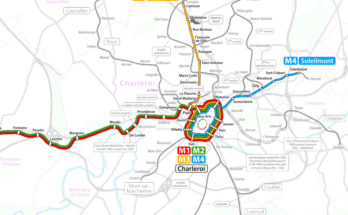Lisbon has a Metro system (subway metropolitan Lisbon Metro) supplemented by a system of urban and suburban train and tram. Lisbon metro is considered one of the most beautiful metro in Europe together with Moscow and Paris. Its stations are both artistic and architectural spaces. It opened in 1959 with a length of 6.5 km. The growth of the network was completed in successive expansion phases. In 1988, after the nationalization of the company, was created Metropolitano de Lisboa EP, (the operator of the underground). Since then carried out the largest expansion and reorganization of the network.
Lisbon Metro Lines
The Lisbon metro consists of 4 lines with 45 km long and 55 stations (6 of them with correspondence)
Scroll through the four lines of the Lisbon subway is very easy and intuitive, thanks to its system of colors, icons and names: Blue-gull, Yellow-sunflower, Green-oriente, and Red-caravel
- Linha da Gaivota (
blue) opened in 1959, runs from Santa Apolonia to Amadora Este, with 14 km and 17 stations. The blue line is very useful for those who are visiting the city center, the stations of Santa Apolonia, Baixa-Chiado and Rossio are the most interesting for tourists. Baixa-Chiado station has a espectacular tiles decor. - Linha do Girassol
(yellow) opened in 1959, runs from Rato to Odivelas, from north to south with 11 km and 13 stations. This station runs through the city’s financial quarter, where the Marquis de Pombal station. Other stations of interest for visitors are the Campo Pequeno due to the bullring just when leaving the station, Cidade Universitaria to know the University of Lisbon, Quinta das Conchas, and Rato, wich is a noble area of the city that has the Botanical Garden very near. - Linha da Caravela (green), opened in 1972, runs from Cais do Sodré to Telheiras completing the circuit of central Lisbon along with the blue line with stations of interest like Rossio, Baixa-Chiado and Cais do Sodre. With a lenght of 9 km and 13 stations.
- Linha Oriente, (red) opened in 1998 runs from S.Sebastiao to the Lisbon Airport, northwest of the city. It was built to connect the Nations Park (which hosted the space Expo’98) with the city. This line serves as a connector to the other lines of the city, connecting the three, the blue, green and yellow, in some points. Its terminal station, Oriente, is considered one of the most beautiful of the Metro and also leads to the bus and train station in the city. It has 11.5 kms and 12 stations.
Future expansions:
In 2014 is scheduled the opening of the extension of the Blue Line from Amadora East to Reboleira train station.
It is also planned the expansion of the Yellow Line at Estrela de Rato (and eventually Alcântara) and the extension of the Red Line to São Sebastão Campolide (and eventually Campo Ourique / Amoreiras)
Stations of interest:
Oriente Station, of the red line. It is a monumental work designed by the architect Santiago Calatrava that has Impressionists tile panels on the ground, a large shopping center and a city bus station, and at the top another regional trains station.
Baixa-Chiado station, blue line, is a very spectacular modernist station decorated with tiles.
Entre Campos station with a collection of statues representing classic trades old Lisbon.
Opening Hours
The Metro starts the service at 06:30 am and stops at 01:00 am (the last trains arrive at the terminal stations at 01:30 am). However, some stations closed exits before 1:00 a.m
Frequency Step
Varies from 4 minutes during peak hours to 8-10 minutes at night.
Fares and Ticket
The tariff system of the Lisbon Metro is integrated into the structure of transport crowns Lisbon Region which is divided into four areas: L, 1, 2 and 3. Most of the metro network is situated within the central crown or Corona L. The Lisbon Metro has a wide variety of tickets which include those for travel only in Metro, combined tickets with transport company Carris (bus and tram), and combined with other operators. Note that the cash payment of bills was abandoned February 1, 2012, and currently there is a rechargeable magnetic ticketing system, which are validated by supporting them in the reader access barriers. This rechargeable card 7 Colinas and Viva Cartão Viagem which cost € 0.50 and are valid for one year and are for use in other modes of transportation.
- Single Ticket, single trip in the metro system, regardless of the distance travelled, 1.25€.
- 1 Day Pass valid for unlimited travel in metro and carris valid for 24 hours since validation. Costs: 5.00€
- 30 Days Pass: valid for metro unlimited travel starting from 29€
- Lisboa Card: is designed for tourists who want to travel and visit the artistic heritage of the Portuguese capital. The Card holders can travel free on metro, bus, tram and elevators, as well as in the Belém train and get 26 free museums in Lisbon and Sintra paying half in many other tourist sites. There are three types: 24, 48 and 72 hours which cost about 13 €, 20 € and 26 € approximately half for children 5 to 11 years. This card is very worthy and is sold in the tourist offices of the city and the Carris tickets kiosks.
More tariff info: http://www.metrolisboa.pt/eng/wp-content/uploads/2012/02/Desd.-Novas-tarifas-set2012-interne-inglest.pdf
Airport
The Lisbon Airport, is located within the urban area of the Portuguese capital and since 2010 is easily accessible with the Metro Red Line, so users should not pay any suburban special supplement to get here, just the price of the ticket for the metro network, 1.25 €
Lisbon Metro Map
This post is also available in: French German Spanish Portuguese (Brazil)
